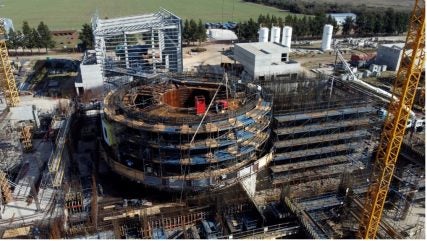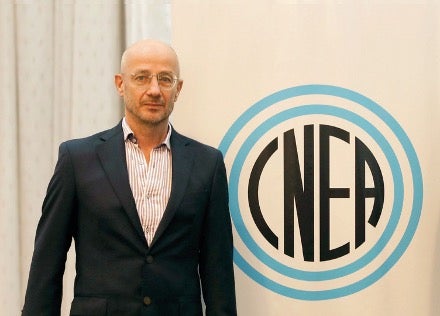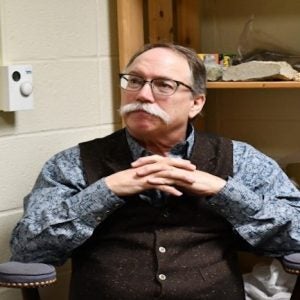
In an exclusive interview with EconoJournal, Germán Guido Lavalle the new president of the Argentina’s National Atomic Energy Commission (CNEA – Comisión Nacional de Energía Atómica), discussed Argentina’s nuclear development plans. Lavalle, who was appointed President in May, is a doctor of Nuclear Engineering graduated from the Balseiro Institute. Between 1996 and 2000 he was manager of International Relations and Technology Transfer at CNEA. Subsequently, he was rector of the Argentine University of Business and of the Technological Institute of Buenos Aires. In 2007 he founded Candoit, a company dedicated to artificial intelligence, software development and engineering consulting.
CNEA is seeking to ensure it has the necessary budget to press ahead with its three major projects – the prototype CAREM small modular reactor (SMR), the multipurpose RA-10 research reactor, and the Proton Therapy Centre.
CAREM (Central ARgentina de Elementos Modulares) is Argentina’s first domestically-designed and developed 32 MWe nuclear power unit. As well as relying on passive safety systems, Carem’s entire primary coolant system is contained within the single self-pressurised vessel and uses free convection to circulate the coolant. This eliminates the need for devices such as pumps within the primary circuit and decreases the extent and complexity of the piping system required. It also reduces the possibility of accidents involving a loss of coolant.
Before work was suspended, it was in line to be the world’s first operating SMR and was expected to begin operation in 2017. Development started in 1980 by CNEA and technology company INVAP and it was first announced in 1984. Progress slowed in the early 2000s but a 2006 government decree made the Carem25 programme a national priority. A second executive order in 2008 made the project directly responsible to the President of Argentina. The government licensed it as a prototype in 2009.
However, the project faced a series of delays due to administrative and financial difficulties. Construction resumed in mid-2021and the project will now go through a Critical Design Review, according to the Chief of Staff, Nicolás Posse, in his first management report recently submitted to the Senate. It is estimated that further investment $260m is needed to complete it.
Lavalle told Econojournal that as an innovative reactor, there were several points that required analysis. “The last critical design review was made a few years ago and it is time, regardless of the project and construction that continues, for a review of the most critical points, more innovative, with a group of experts that can say ‘here we are fine’ and ‘here you have to be careful’, etc. The expert group has already been defined and work is beginning.”

Asked how long the review would take he replied: “We put a maximum period of 60 calendar days, I hope it is less. The expert group has to identify those aspects that require a review or redesign, in particular the most innovative aspects of the reactor.”
As to the future, Lavalle noted that to date most of the focus has been on the civil works. “The review is about engineering systems, basically the things that go inside the reactor, which are not yet manufactured, there are some components that are being done. The review may say, look, this modification should be made, these measurements made, or these tests done, that’s what the experts are expected to conclude.”
He pointed out that project engineering, for the most innovative aspects it is necessary to have a plan B “in case this doesn’t work” or “doesn’t work quite well”. That is what the experts have to review. “This is a normal average procedure in this type of works and I understand that the responsibility I am taking, as we invest public funds, is to make sure that it will come to fruition, and this is the mechanism that we engineers have to verify it.”
On the question of opening the project to the participation of a private partner, he noted: “I have not had the opportunity to argue with any investor who wants to, nor do we have a defined policy on this. But welcome if there is a private partner who wants to join this project.”
Lavalle was also asked about the RA-10 reactor and Proton Therapy Centre. The RA-10 multi-purpose research reactor at Ezeiza Atomic Centre (CAE – El Centro Atómico Ezeiza) in Buenos Aires province, – a 30 MWt open-pool research reactor – will be used for the production of medical radioisotopes and key research and training. It is based on the OPAL radioisotope production reactor that private technology company INVAP (from INVestigación APlicada – applied research) supplied to Australia in 2007. It will replace the 10 MWt RA-3 reactor on the same site, which began operations in 1967.
The RA-10 is now about 80% completed, according to project manager Herman Blaumann. The project was approved by the government and was officially started by CNEA in June 2010. Argentina’s Nuclear Regulatory Authority granted a construction licence in 2014 and civil works began in 2016. INVAP is the main contractor. The assembly of the RA-10 pool – which will house the core of the reactor – was completed in August 2018. According to Blaumann the aim is to fill the reactor pool in December after which pre-operational tests will begin in July 2025 for operation in 2026.
The RA-10 will have a complex of associated facilities such as the Argentine Neutron Beam Laboratory (LAHN), the Laboratory for the Study of Irradiated Materials (LEMI) and the Radioisotope Production Plant (PPRF). The Government says the RA-10 will require an estimated investment of $60m to complete, while the Proton Therapy Centre will need $7m to start supplying some nuclear medicine services this year for full operation in 2025.
Lavalle said the RA-10 is a priority. “It is a reactor whose production of radio isotopes generates enormous interest in the world. The goal is to finish that project as soon as possible. I get calls from all over the world from those who want to buy the reactor products, so there is a lot of interest. It is estimated that it will take a year and a half to start production and we will try to meet that deadline.”
On the Proton Therapy Centre, he pointed out that it will be the first in Latin America that would use the technology to treat tumours more precisely than with the other methods. “It is more precise, it makes it possible to attack the tumour, without affecting the good cells that surround it. That’s very good, particularly … for the children, where all the organs are smaller, and where that precision adds even more value. With some of the auxiliary equipment that we are building in the centre, we hope that in the coming months we will be able to provide services to the public.”
EconoJournal noted that the Ministry of Energy had reported that the extended the 2023 budget for CNEA to meet the expenses of the institution approximately until May or June and asked what would happen to the budget for the rest of the year.
Lavalle pointed out that the entire national public administration does not have a 2024 budget because Congress did not approve it and so it was necessary to extend the 2023 budget. “The entire public administration is in the same situation, the universities, the agencies, the ministries – all have in principle an extended budget. Given inflation, obviously, that budget extends to the middle of the year…. So, on this extension, all these organisations are asking for an extension of the budget credit. That is what we did at the commission. The CNEA is following this course with favourable messages from the Ministry of Economy – that there is no budget up to June but there are no cuts. In some areas we already have a positive response. And in others we have made reformulations sothat we will have a budget by December, as appropriate.
Lavalle said CNEA wanted to encourage more technology companies. “CNEA has a few thousand people, hundreds of laboratories where new things appear every day. We understand that it is a result that we owe to society to generate more technology-based companies from these researches. The task we have to do is facilitate that, support, get the necessary capital. All the big universities or science and technology organisations put a lot of focus on this, understanding that it generates not mainly money for the institution but good for society to have these companies and that they are successful.”






